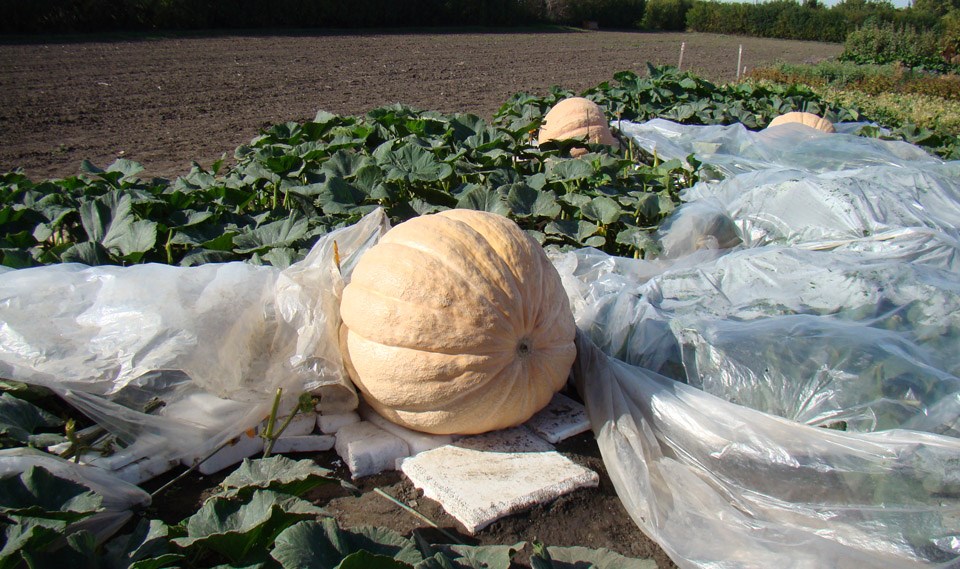Howard Dill is perhaps the most famous large pumpkin grower of the last century. Dill is known for winning four straight world titles for growing the largest pumpkin. His famous Dill’s Atlantic Giant pumpkin seed is a must-have for those of us who are trying to grow a gigantic pumpkin.
To successfully grow a large pumpkin in our relatively short growing season, start pumpkin transplants indoors about two weeks before you plan to transplant outdoors. Pumpkin seeds should be sown in peat pots or Jiffy 7s so that roots will not be disturbed when transplanted. Two weeks is ample time to produce a pumpkin transplant. Transplants that have more than two true leaves will not transplant well. Avoid long, leggy transplants. The first two leaves to emerge from the seed will be the cotyledons; after that, the first true leaf will emerge.
It may be just as easy to direct seed pumpkins into the soil. When direct seeding, ensure that the soil is warmed up to at least 20 C. Warm temperatures encourage speedy germination and quick emergence. Place a clear plastic sheet on the ground. Tightly secure the edges of the plastic with soil or heavy 2 x 6 boards: this will warm up the soil early in spring. Pumpkin plants should be spaced three square metres apart. Poke small holes (about five centimetres diameter) into the plastic sheet and direct seed the pumpkin seed into the soil (about two centimetres deep). Water the seeded holes lightly. As seedlings emerge, they will grow out of the plastic through the holes. The clear plastic can remain on the soil throughout the season as it will continue to warm the soil and encourage good pumpkin vine growth.
Avoid using organic mulch such as grass clippings or leaves around the base of the pumpkin plant, as this will reduce soil temperatures and slow plant growth. As soon as seedlings have emerged or immediately after transplanting, water in the transplants or tiny seedlings with a 10-52-10 soluble fertilizer mixed according to label directions. Apply 20-20-20 soluble fertilizer every two weeks until fruit set (late June). After fruit set, fertilizer weekly with 20-20-20 fertilizer.
Pumpkin plants require a lot of water. Initially, apply 2.5cm of water/week. By mid-July, increase watering to 2.5cm of water, twice weekly.
Pumpkins love heat. Agricultural crop covers warm up the air and soil around the plants. Place crop covers over the plants as soon as they are transplanted or emerged from the soil. Agricultural crop covers can be purchased at your local garden center and have different weights. Some crop covers are referred to as ‘frost blankets’: these are a bit heavier weight and can limit the amount of light reaching the plant under the cover. Covers that have a weight of 0.5 oz/yd2 are recommended for large pumpkin production: these covers will warm air temperatures around the plant and allow 85% light transmission. The only time you must remove crop covers is during flower pollination (third or fourth week in June) and to weed the garden.
Pumpkin fruit is produced by cross pollination. The first flowers that appear on the pumpkin plant are male flowers. The pollen is ready to use from these male flowers when it comes off easily from the stamens onto your fingers. Female flowers will appear several days to one week after the male flowers. Female flowers are very obvious in that they have a small pumpkin located beneath the flower petals and the stem. To pollinate the female flower, carefully remove the male flower from the plant and rub the stamens over the interior parts of the female flower. Follow this same process for several flowers. After several days, the female flowers that are pollinated will continue to grow, whereas the tiny fruit on non-pollinated female flowers will wither and die. You can leave the pollination process up to bees and other pollinators; however, they may not be as efficient as you.
To produce a giant pumpkin, once the fruit reaches the size of a basketball, thin pumpkins to one fruit per plant. Remove any other developing fruit and flowers throughout the season. Removing excess fruit and flowers focuses all of the plant resources into producing one giant fruit. Replace crop covers after fruit set.
As the pumpkin grows and matures, minimize the length of the vine: the main stem should not exceed 5m while the secondary stems should not exceed 3m. Throughout the season, the weight of the pumpkin will cause the fruit to flatten. If possible, turn the pumpkin slightly to ensure a more rounded shape. Be careful not to damage the fruit or the vines during this process. Moving a very large pumpkin on the vine will not be possible later in the season.
Not all pumpkin cultivars are created equal. If you want to grow a record-breaking pumpkin, start with seed from a big pumpkin. ‘Dill’s Atlantic Giant’ is probably the best-known cultivar for growing record-breaking pumpkins. If you happen to grow your large pumpkin, maybe you can sell the seed. Some websites are selling giant pumpkin seeds at $349.00 for one seed!
This column is provided courtesy of the Saskatchewan Perennial Society (SPS; [email protected]). Check our website () or Facebook page () for a list of upcoming gardening events.




